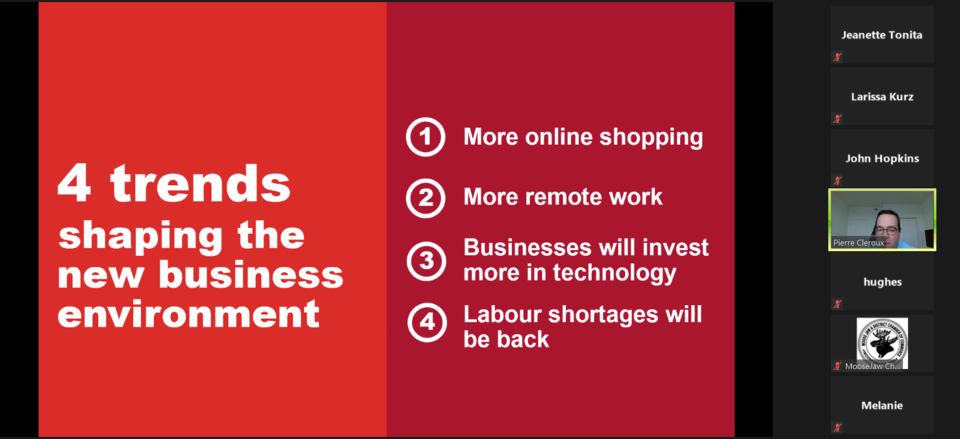During a presentation hosted by the Regina & District Chamber of Commerce, economist Pierre Cleroux said that experts are expecting the provincial and national economies to recover relatively quickly in 2021 — but that businesses shouldn’t expect things to be exactly the same as before.
Cleroux, vice-president of Business Development Bank of Canada (BDC), spoke with Regina and Moose Jaw chamber members about what to expect from business trends in 2021.
Canada’s economy took a hit in 2020 due to the COVID-19 pandemic, with a negative growth of and an estimated 3 million jobs lost — two-thirds of which have since been recovered.
Saskatchewan also experienced the effects of the pandemic, losing an estimated 70,000 jobs during the first lockdown and seeing a decrease in revenue in several industries such as culture and recreation, hospitality and food services, and even agriculture.
The province also recovered about two-thirds of those jobs lost, but is still looking at just over 20,000 jobs still missing.
But the numbers aren’t all bad news, said Cleroux, as the economy’s quick snap back following the lifting of restrictions back in the fall offers a positive picture for the future.
“That’s something we learned in 2020, is when you lift the restrictions, the economy is coming back very quickly, which is quite positive for the recovery,” said Cleroux. “There’s also more money in Canadians’ pockets because of government programs [and] they’re going to spend it in 2021.”
Some industry sectors are still struggling, but experts remain optimistic about Canada’s economic recovery in 2021, especially compared to other countries. Manufacturing cells are returning to normal production rates, including the wood manufacturing industry in Saskatchewan.
Saskatchewan’s exports increased by 2.5 per cent last year — an exception in Canada, as the national number show an 11.8 per cent decrease in exports — which includes the province’s exports of lentils, which increased by 96 per cent in 2020.
Cleroux predicted Canada’s economic growth will be over five per cent this year. This is due to a number of reasons including the promise of widespread vaccination, rising oil prices, continue government stimulus programs and low interest rates, increased investment intentions, and the $212 billion in savings Canadians are reported to have held onto in 2020.
For business owners, Cleroux advised that there will be a number of new trends sticking around even post-pandemic.
Investing in an online presence will continue to be relevant said Clereux, as the pandemic has only kick-started the importance of online business. E-commerce sales more than doubled in the last year, and a large number of Canadians polled that they will continue to shop online when possible.
“According to our research, 42 per cent of Canadians say they are going to increase their online spending in the next six months, and when you talk to young people, that ratio is 50 per cent,” said Cleroux. “[And] if you’re not online, you’re kind of invisible. . . Even if people don’t buy online, they still go on the web to see what’s available.”
Businesses should also expect working from home to stick around, as well as continued increases in tech investment. Labour shortages are also likely to continue, as immigration numbers have decreased.
He also added that while Canada entered into the pandemic with a strong GDP, it also spent the most stimulus money during the subsequent months of 2020.
He anticipates the federal government will not be attempting to balance the budget for several years as a result.
COVID-19 continues to be the biggest risk factor that could disrupt a successful economic recovery, said Cleroux, but experts remain optimistic based on the current trajectory.
“This virus is full of surprises, but we are optimistic for recovery and we need the vaccination to work [for that to happen.] That’s really the strongest condition for this strong recovery,” said Cleroux.




